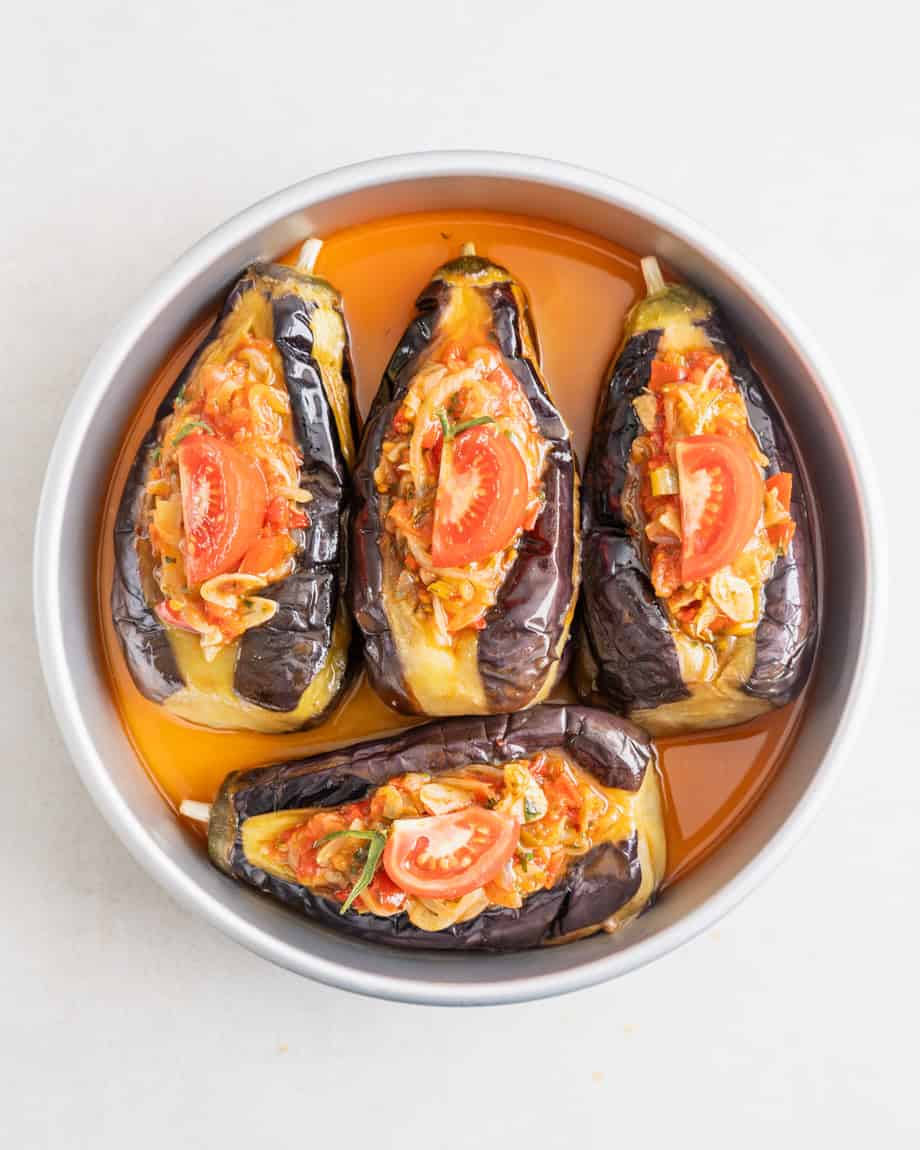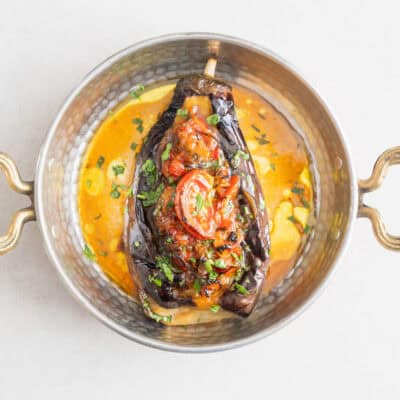İmam Bayıldı (Turkish Stuffed Eggplants)

What is İmam bayıldı?
İmam bayıldı is so delicious that “the imam fainted” when he tried it. Or at least, that’s how the story goes according to the most common translation of the dish’s name. Though “bayıldı” does indeed translate to “to faint”, most Turks will argue that that’s not the intended meaning in this case. Instead, it simply means that the imam (a religious leader) was crazy about it. Either way, it alludes to the deliciousness of the dish, and on that note hardly anyone will disagree.
This İmam bayıldı recipe features tender eggplants stuffed with a luscious mixture of onions, garlic, peppers and tomatoes, all simmered in olive oil. The dish is traditionally vegan, often served cold or at room temperature, making it a perfect side dish, or main course if served with pilav.
History of İmam bayıldı
The history of İmam bayıldı is steeped in Ottoman culinary traditions. It dates back several centuries, with various legends surrounding its creation. One popular tale suggests that a wealthy imam married the daughter of an olive oil merchant, and as part of her dowry, she brought with her a vast amount of high-quality olive oil. When she prepared this dish for him, using copious amounts of the oil, the imam was so impressed by the richness that he fainted. Still today it remains a beloved dish in Turkish cuisine, celebrated for its simplicity, richness and depth of flavor.
Türkiye’s Zeytinyağlılar
İmam bayıldı is one of many Zeytinyağlılar, a category of Turkish cuisine that refers to dishes cooked in olive oil. The term literally means “those with olive oil.” These dishes are typically made with vegetables and served cold or at room temperature alongside bread or rice. They are known for being light, healthy and flavorful and a powerful example of how cultural can just happen to be plant-based.
Vegan Cultures
When I travelled to Türkiye to explore its naturally vegan food for my YouTube series Vegan Cultures, I met up with Sinem Ozler of the highly praised İstanbul restaurant Seraf Vadi. Together, we cooked two traditional Zeytinyağlılar, and one of them was her smoky version of İmam bayıldı. Watching her char the eggplants and then stuffing them with the slow-cooked onion filling was inspiring – a lesson that a traditional dish can take on a slightly new form (by peeling and charring the eggplants) but still maintain its authentic roots.
Ingredients You’ll Need & How to Substitute
To make İmam bayıldı, you will need the following ingredients:
- Eggplants: Smaller eggplants that are long and slender are ideal, though more difficult to get. You can use small globe eggplants instead.
- Onions: Thinly sliced to form the base of the filling.
- Garlic: Finely sliced to add depth and aroma.
- Tomatoes: Fresh, ripe tomatoes for a juicy, flavorful filling. The excess juices make the perfect braising liquid.
- Green peppers: Sliced for added flavor and texture. You can use more red peppers instead.
- Long red peppers: Sliced for added flavor and texture. You can use more green peppers instead.
- Extra Virgin Olive oil: A generous amount is essential, as it’s the key to the dish’s richness.
- Parsley: Freshly chopped, to garnish and add a burst of freshness.
- Pul Biber (Aleppo pepper): For a little bit of heat. You can use chili flakes instead.
How to make İmam bayıldı (step-by-step)
Prepare the Eggplants. Trim the bottom ends of each eggplant and peel back the green tops. Then use a paring knife to make a circular incision around the base of the stem and pull off the green part, revealing the woodier core. Now peel off alternate long stripes of the eggplants, resembling a zebra pattern. 

Place the eggplants in a large bowl and rub 1 tablespoon (14g) of salt all over the exposed flesh. Set aside until needed.

Cook the Filling. Meanwhile, make the filling. Heat 4 tablespoons of the olive oil in a casserole over medium-low heat. Peel and finely slice the onions, add them to the casserole with 1 1/2 teaspoons (10g) of salt and cook until they are soft and translucent (8-10 minutes). Peel and slice the garlic cloves. Cut the red and green pepper in half, remove the core and seeds and slice the rest. Add the garlic and peppers to the pan and continue cooking for 10 minutes more until the peppers have softened as well. Dice 2 1/2 of the tomatoes, add them to the pan with the pul biber and cook covered for 5 minutes to let the tomatoes release their juices. Trim and discard the lower stems of the parsley and chop the rest. Turn off the heat, stir most of the parsley into the filling (refrigerate the rest until later), then strain the filling through a sieve placed over a bowl to catch the juices.

Fry the Eggplants. Pre-heat the oven to 220°C (200°C fan) and pat dry the eggplants with some kitchen paper. Heat 5 tablespoons of olive oil in a frying pan over medium heat and fry the aubergines (careful, they will splash as they release moisture), turning them every 2-3 minutes, until they have softened and look golden on the peeled spots (8-12 minutes total). Stuff the Eggplants. Transfer the fried eggplants to a walled baking dish and make a lengthwise incision, ideally along a peeled strip, just 2cm deep and leaving around 2cm at the top and bottom. Then use two spoons to open it like a pocket and stuff them evenly with the filling. You can serve any leftover filling as a side later on.

Add 1/2 teaspoon (3g) of salt to the leftover cooking juices and drizzle the mixture over and around the eggplants. If needed, top it up with enough water to cover the bottom of the dish with 1-2cm of liquid. Quarter the remaining tomato half lengthwise and place a piece on top of each filled eggplant. Drizzle a little more extra virgin olive oil all over.

Roast. Roast for 30 minutes until lightly charred.

Serve. Let it cool to room temperature, divide over plates, drizzle with some cooking liquid from the baking dish and serve with a drizzle of olive oil and the reserved parsley.
Useful Tips
- Choose the right eggplants: Smaller, slender eggplants work best as they soften quickly and are perfect for stuffing.
- Don’t skimp on the olive oil: This dish relies heavily on olive oil for its rich flavor and texture. Using good quality extra virgin olive oil will make a difference.
- Strain the juices: Straining the cooked filling doesn’t only intensify the flavor, it gives you the perfect leftover braising liquid that can be poured over the eggplants and into the tray.
- Stuffing the eggplants: Make an incision on a peeled spot, that way it is easier to stuff without tearing, and also visually more pleasing.
- Serve it cold: This dish is traditionally served cold or at room temperature, which allows the flavors to fully develop.
- Make it ahead: İmam bayıldı tastes even better the next day as the flavors have time to meld. It’s a great dish to prepare in advance.
- Turn it into a main: Serve it with freshly cooked rice for a hearty meal. The rice is also the perfect vessel to scoop up all of the leftover cooking juices.
Why You’ll Love This İmam bayıldı Recipe
- naturally & traditionally vegan
- an exciting way to serve eggplants
- packed with veg
- can be made ahead
How to Store İmam bayıldı
İmam bayıldı can be stored in an airtight container in the refrigerator for up to 3-4 days. The dish actually improves in flavor as it sits, making it a perfect make-ahead option. Either serve it cold or let it come to room temperature. Freezing is not recommended, as the texture of the eggplants may become mushy when thawed.
Other Turkish Recipes You Might Like
- Kuru Fasulye: A spicy white bean stew, Türkiye’s national dish
- Çiğ Köfte: Spiced Bulgur Balls
- Kısır: A fragrant bulgur salad
- Mercimek Köftesi: Lentil and bulgur balls that are eaten in salad leaves with plenty of lemon juice
**I receive a small commission from affiliate links on this page**

İmam bayıldı (Turkish Stuffed Eggplants)
Ingredients
Instructions
- Trim the bottom ends of each eggplant and peel back the green tops. Then use a paring knife to make a circular incision around the base of the stem and pull off the green part, revealing the woodier core. Now peel off alternate long stripes of the eggplants, resembling a zebra pattern. Place the eggplants in a large bowl and rub 1 tablespoon (14g) of salt all over the exposed flesh. Set aside until needed.
- Meanwhile, make the filling. Heat 4 tablespoons of the olive oil in a casserole over medium-low heat. Peel and finely slice the onions, add them to the casserole with 1 1/2 teaspoons (10g) of salt and cook until they are soft and translucent (8-10 minutes). Peel and slice the garlic cloves. Cut the red and green pepper in half, remove the core and seeds and slice the rest. Add the garlic and peppers to the pan and continue cooking for 10 minutes more until the peppers have softened as well.
- Dice 2 1/2 of the tomatoes, add them to the pan with the pul biber and cook covered for 5 minutes to let the tomatoes release their juices. Trim and discard the lower stems of the parsley and chop the rest. Turn off the heat, stir most of the parsley into the filling (refrigerate the rest until later), then strain the filling through a sieve placed over a bowl to catch the juices.
- Pre-heat the oven to 220 °C (428 °F) (200 °C (392 °F)) and pat dry the eggplants with some kitchen paper. Heat 5 tablespoons of olive oil in a frying pan over medium heat and fry the eggplants (careful, they will splash as they release moisture), turning them every 2-3 minutes, until they have softened and look golden on the peeled spots (8-12 minutes total).
- Transfer the fried eggplants to a walled baking dish and make a lengthwise incision, ideally along a peeled strip, just 2cm deep and leaving around 2cm at the top and bottom. Then use two spoons to open it like a pocket and stuff them evenly with the filling. You can serve any leftover filling as a side later on.
- Add 1/2 teaspoon (3g) of salt to the leftover cooking juices and drizzle the mixture over and around the eggplants. If needed, top it up with enough water to cover the bottom of the dish with 1-2cm of liquid. Quarter the remaining tomato half lengthwise and place a piece on top of each filled eggplant. Drizzle a little more extra virgin olive oil all over.
- Roast for 30 minutes until lightly charred. Let it cool to room temperature, divide over plates, drizzle with some cooking liquid from the baking dish and serve with a drizzle of olive oil and the reserved parsley. Pairs well with some freshly cooked pilav.


This Worked out perfectly! I also Made The pilav ????
Amazing!! That’s wonderful to hear.
One of the best yet!
Thank you very much!
Are the green and red peppers spicy or mild? Or do they have a specific name I’m in the us and want to purchase the correct ones! Thanks!
They are both mild. The Pul Biber adds a little heat 🙂